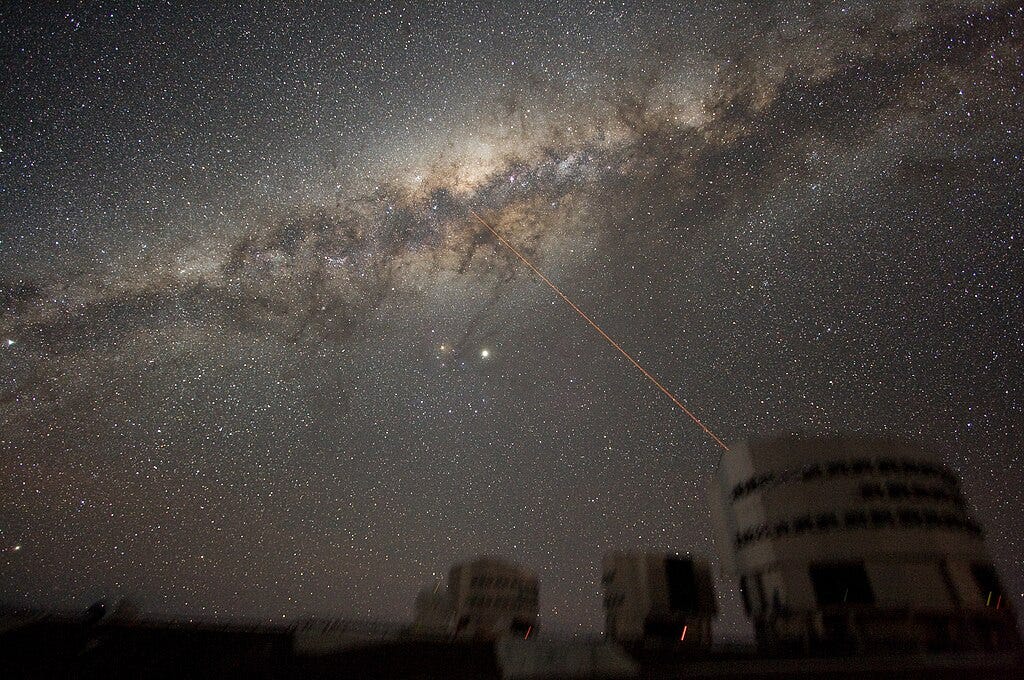🏷️ Categories: Loneliness, Mathematics, Astronomy
"The universe is a pretty place. If it's just us, it seems like a horrible waste of space." Carl Sagan, Contact
Music for today's letter:
Los Alamos, California, United States, 1950.
One ordinary afternoon in the busy Los Alamos laboratory, Enrico Fermi, an Italian physicist, was chatting with some of his colleagues. The conversation revolved around a subject that has always fascinated mankind (and not only physicists): the possibility of life on other planets.
Science had advanced by leaps and bounds and the dream of space travel no longer seemed so distant. As they chatted, Fermi threw out a question that left the rest of the group thoughtful: "Where is everyone?"
If the universe is so vast and ancient, and life and intelligence are not phenomena unique to Earth, why haven't we found life out there yet?
The Cosmic Scenario
There are too many planets for us to be alone.
Our galaxy alone, the Milky Way, contains between 100 and 400 billion stars. In addition, there are approximately two trillion galaxies in the observable universe alone, yes, only in the observable universe alone we are 1 planet out of 800 000 000 000 000 000 000 000 000 000 000, not bad. A drop in the ocean.
Moreover, the physics and chemistry that gave rise to life are universal; this is demonstrated by aminoacids found in meteorites from interstellar space (Iglesias-Groth, 2023).
With such a colossal number of planets, it is inevitable that life exists elsewhere.
The Drake Equation
Astronomer Frank Drake in 1961 tried to make sense of the Fermi paradox.
There are many planets, but how many are habitable? He devised an equation to estimate the number of civilizations in the Milky Way with which we could communicate. Seven factors were taken into account:
Star formation rate.
Fraction of those stars formed that have planets.
Fraction of those planets that could support life
Fraction of those planets on which life arises
Fraction of those planets where life arises and is intelligent
Fraction of those with intelligent life and with technology that we can detect
Duration during which these civilizations emit detectable signals.
With so many planets, some of them must meet these terms, right? right...?
There is a lack of data. The difficulty of finding communicating intelligent life may be very high or very low, we can't know exactly, although it seems quite rare.
The 5 answers to the Fermi paradox
There are 5 hypotheses that would answer the question "Where is everyone?"
Rarity of Life and Intelligence:
Maybe intelligent life is extremely rare.
Although the conditions for life may be present in many places, the transition from inanimate matter to life and then to advanced intelligence could be an extremely unlikely event.
This is the Rare Earth Hypothesis (Cramer, 2000).
Risk of self-destruction:
Maybe they have destroyed themselves.
Another possibility is that technological civilizations tend to self-destruct before they can communicate or colonize other stars (Bostrom & Ćirković, 2012).
Nuclear war, climate change, pandemics, and other self-inflicted disasters could limit the longevity of advanced civilizations. We are the best example.
Intentional Isolationism:
Maybe they don't want to communicate.
The Drake equation calculated the probability of other intelligent civilizations emitting signals, what if they don't want to emit them? There may be many civilizations but they choose not to interact for reasons such as fear of threats or not to interfere with our development.
This is the zoo hypothesis (Crawford & Schulze, 2023).
Technological Invisibility:
Maybe we do not understand each other or messages do not get through.
If these civilizations use means of communication not perceptible with our current technology, we would simply not be able to detect them. Another possibility is that with how vast the universe is, their signals have not yet arrived nor have we received their signals (Webb, 2002; Baum et al., 2011).
The Great Filter:
Maybe no one got that far.
Somewhere between the formation of life and reaching a civilization capable of colonizing space there is an almost insurmountable hurdle (Hanson, 1998).
We could be the first beings to have overcome the biggest hurdles (reaching intelligent life and having technology) or we could be the slowest (we are not yet able to colonize planets or travel very fast).
Hope is the last thing to be lost
Despite the lack of evidence for life, the search continues.
Programs such as SETI (Search for Extraterrestrial Intelligence) use radio telescopes to search for radio signals from distant civilizations.

In addition, space missions, such as the Kepler space telescope and the more recent James Webb telescope, have discovered thousands of planets, some with very promising characteristics.
Exploring our solar system also remains a priority. Places like Mars, Europa (a moon of Jupiter) and Enceladus (a moon of Saturn) are key targets because of the possible presence of liquid water.
Hopefully one day we will lose the privilege of being the only inhabited planet to be one of many.
And what do you think, are we so alone? I would love to still be alive the day life is discovered out there.
See you soon! 🚀☄️
📚 References
Baum, S. D., Haqq-Misra, J. D., & Domagal-Goldman, S. D. (2011). Would contact with extraterrestrials benefit or harm humanity? A scenario analysis. Acta Astronautica, 68(11-12), 2114-2129. https://doi.org/10.1016/j.actaastro.2010.10.012
Bostrom, N., & Ćirković, M. M. (2012). Global catastrophic risks. Oxford University Press.
Cramer, J. (2000). The" Rare Earth" Hypothesis.
Crawford, I. A., & Schulze-Makuch, D. (2023). Is the apparent absence of extraterrestrial technological civilizations down to the zoo hypothesis or nothing? Nature Astronomy. https://doi.org/10.1038/s41550-023-02134-2
Hanson, R. (1998, 15 septiembre). The great filter. https://mason.gmu.edu/~rhanson/greatfilter.html
Iglesias-Groth, S. (2023). A search for tryptophan in the gas of the IC 348 star cluster of the Perseus molecular cloud. Monthly Notices Of The Royal Astronomical Society, 523(2), 2876-2886. https://doi.org/10.1093/mnras/stad1535
Sagan, C. (2016). Contact. Simon and Schuster.
Powell, A. (2009, 7 mayo). Life in the universe? Almost certainly. Intelligence? Maybe not. Harvard Gazette. https://news.harvard.edu/gazette/story/2009/05/life-in-the-universe-almost-certainly-intelligence-maybe-not/
Webb, S. (2002). If the Universe Is Teeming with Aliens . . . WHERE IS EVERYBODY?: Fifty Solutions to the Fermi Paradox and the Problem of Extraterrestrial Life. Springer Science & Business Media.








Humanity's history reflects a truth that our reaction to contact with other intelligent? life is to snuff it out. If there is intelligent life 'out there', and they have developed technology capable of communicating with us, the likelihood is that they know what we are like, and, therefore, would avoid at all costs having anything to do with us. I would, and I am not all that intelligent.
Good article. What about the fact that most potential planets are so far away that evidence of their development and perhaps even death has not yet traveled this far? Our technological development to the ability to detect others is less than 100 years. An instant. How far could light travel in 100 years and how many potential life sites are within that parameter?